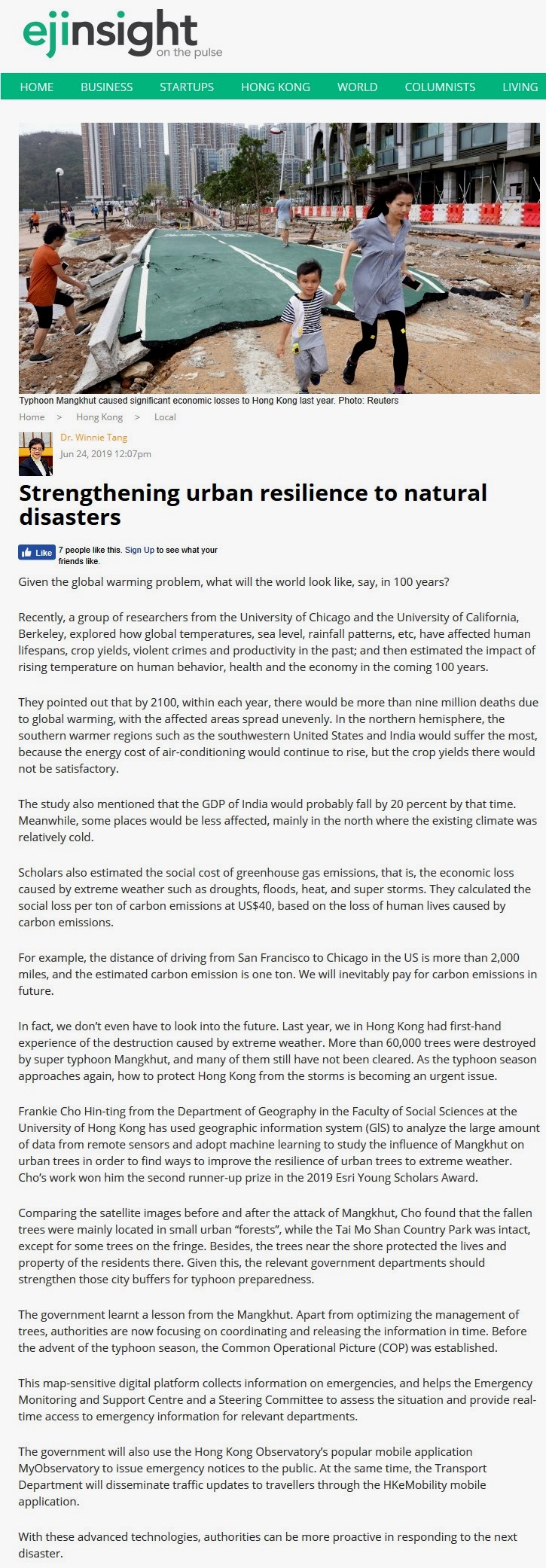網上版請按此

Strengthening urban resilience to natural disasters
Given the global warming problem, what will the world look like, say, in 100 years?
Recently, a group of researchers from the University of Chicago and the University of California, Berkeley, explored how global temperatures, sea level, rainfall patterns, etc, have affected human lifespans, crop yields, violent crimes and productivity in the past; and then estimated the impact of rising temperature on human behavior, health and the economy in the coming 100 years.
They pointed out that by 2100, within each year, there would be more than nine million deaths due to global warming, with the affected areas spread unevenly. In the northern hemisphere, the southern warmer regions such as the southwestern United States and India would suffer the most, because the energy cost of air-conditioning would continue to rise, but the crop yields there would not be satisfactory.
The study also mentioned that the GDP of India would probably fall by 20 percent by that time. Meanwhile, some places would be less affected, mainly in the north where the existing climate was relatively cold.
Scholars also estimated the social cost of greenhouse gas emissions, that is, the economic loss caused by extreme weather such as droughts, floods, heat, and super storms. They calculated the social loss per ton of carbon emissions at US$40, based on the loss of human lives caused by carbon emissions.
For example, the distance of driving from San Francisco to Chicago in the US is more than 2,000 miles, and the estimated carbon emission is one ton. We will inevitably pay for carbon emissions in future.
In fact, we don't even have to look into the future. Last year, we in Hong Kong had first-hand experience of the destruction caused by extreme weather. More than 60,000 trees were destroyed by super typhoon Mangkhut, and many of them still have not been cleared. As the typhoon season approaches again, how to protect Hong Kong from the storms is becoming an urgent issue.
Frankie Cho Hin-ting from the Department of Geography in the Faculty of Social Sciences at the University of Hong Kong has used geographic information system (GlS) to analyze the large amount of data from remote sensors and adopt machine learning to study the influence of Mangkhut on urban trees in order to find ways to improve the resilience of urban trees to extreme weather. Cho's work won him the second runner-up prize in the 2019 Esri Young Scholars Award.
Comparing the satellite images before and after the attack of Mangkhut, Cho found that the fallen trees were mainly located in small urban "forests", while the Tai Mo Shan Country Park was intact, except for some trees on the fringe. Besides, the trees near the shore protected the lives and property of the residents there. Given this, the relevant government departments should strengthen those city buffers for typhoon preparedness.
The government learnt a lesson from the Mangkhut. Apart from optimizing the management of trees, authorities are now focusing on coordinating and releasing the information in time. Before the advent of the typhoon season, the Common Operational Picture (COP) was established.
This map-sensitive digital platform collects information on emergencies, and helps the Emergency Monitoring and Support Centre and a Steering Committee to assess the situation and provide real-time access to emergency information for relevant departments.
The government will also use the Hong Kong Observatory's popular mobile application MyObservatory to issue emergency notices to the public. At the same time, the Transport Department will disseminate traffic updates to travellers through the HKeMobility mobile application.
With these advanced technologies, authorities can be more proactive in responding to the next disaster.
Dr. Winnie Tang
Adjunct Professor, Department of Computer Science, Faculty of Engineering and Faculty of Architecture, The University of Hong Kong